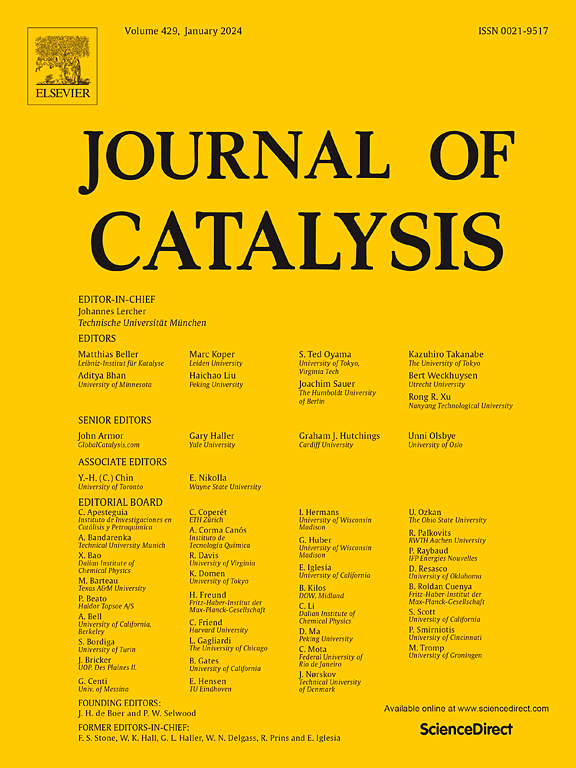Efficient conversion of fructose to 5-hydroxymethylfurfural by hydrophobic modified SAPO-34 molecular sieve
IF 6.5
1区 化学
Q2 CHEMISTRY, PHYSICAL
引用次数: 0
Abstract
To address the issue of the accumulation of water around Brønsted acid sites during the fructose dehydration towards 5-hydroxymethylfurfural (HMF), in this work, hydrophobic SAPO-34 is prepared by post-treatment silanization by grafting alkyl hydrophobic groups on its surface. The SAPO-34 catalyst modified with dodecyl trimethoxysilane exhibits a significantly enhanced yield of 5-hydroxymethylfurfural (HMF), reaching 95.05 %. It is determined that long-chain hydrophobic groups facilitate the forward reaction of fructose dehydration by creating a microenvironment favorable for water removal and fructose enrichment. Furthermore, it releases Brønsted acid sites from water molecules, and enhance fructose’s accessibility to Brønsted acid sites. Thus, the activity, selectivity and durability of SAPO-34 can be promoted simultaneously, due to the selective removal water rather than fructose. This work put insight into the role of alkyl chain length of hydrophobic groups in promoting fructose dehydration towards HMF, which may be guideline for other dehydration reactions restricted by water.
为了解决果糖脱水制取 5-hydroxymethylfurfural (HMF) 过程中布氏酸位点周围水分积累的问题,本研究通过在表面接枝烷基疏水基团进行后处理硅烷化来制备疏水性 SAPO-34。经十二烷基三甲氧基硅烷修饰的 SAPO-34 催化剂显著提高了 5-羟甲基糠醛 (HMF) 的产率,达到 95.05%。研究确定,长链疏水基团通过创造有利于脱水和富集果糖的微环境,促进了果糖脱水的正向反应。此外,长链疏水基团还能从水分子中释放出布氏酸位点,提高果糖对布氏酸位点的可及性。因此,由于选择性地去除水而不是果糖,SAPO-34 的活性、选择性和耐久性可以同时得到提高。这项研究深入探讨了疏水基团的烷基链长度在促进果糖脱水生成 HMF 过程中的作用,这可能为其他受水限制的脱水反应提供指导。
本文章由计算机程序翻译,如有差异,请以英文原文为准。
求助全文
约1分钟内获得全文
求助全文
来源期刊

Journal of Catalysis
工程技术-工程:化工
CiteScore
12.30
自引率
5.50%
发文量
447
审稿时长
31 days
期刊介绍:
The Journal of Catalysis publishes scholarly articles on both heterogeneous and homogeneous catalysis, covering a wide range of chemical transformations. These include various types of catalysis, such as those mediated by photons, plasmons, and electrons. The focus of the studies is to understand the relationship between catalytic function and the underlying chemical properties of surfaces and metal complexes.
The articles in the journal offer innovative concepts and explore the synthesis and kinetics of inorganic solids and homogeneous complexes. Furthermore, they discuss spectroscopic techniques for characterizing catalysts, investigate the interaction of probes and reacting species with catalysts, and employ theoretical methods.
The research presented in the journal should have direct relevance to the field of catalytic processes, addressing either fundamental aspects or applications of catalysis.
 求助内容:
求助内容: 应助结果提醒方式:
应助结果提醒方式:


